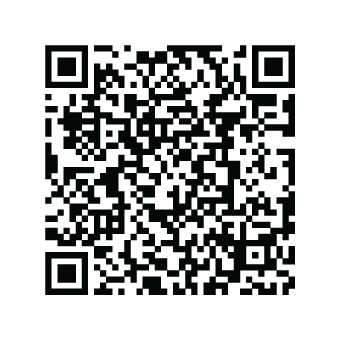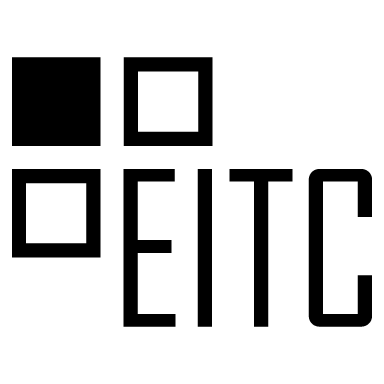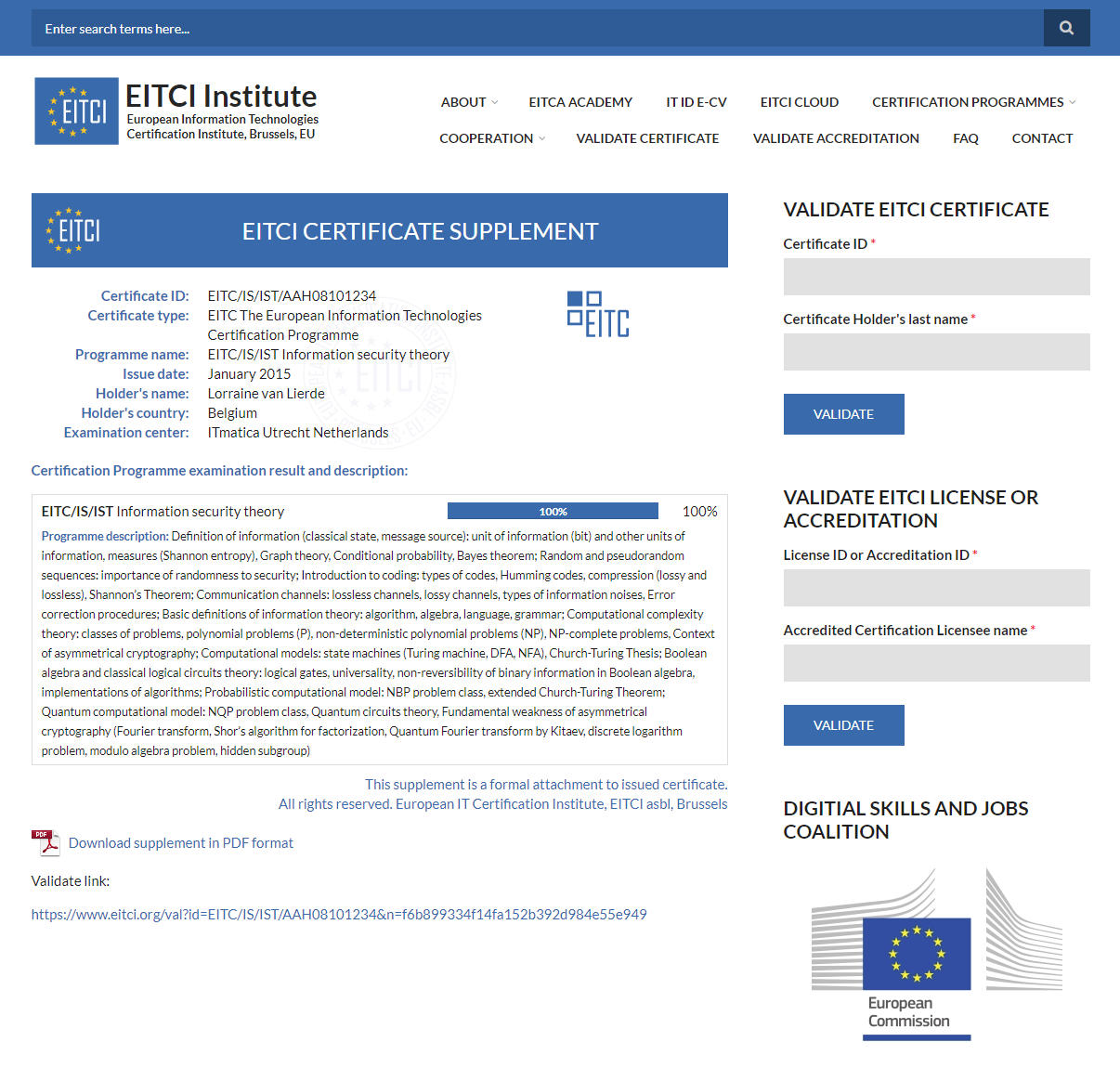Skills certification with international recognition
Secure digital validation of all issued certificates
Permanent validity — no recertification required
Expert committees programming the curriculum
Curriculum of 15 hours — finish it even in 2 days
Complete reference didactic materials included
Learning and exam fully online on your schedule
Online consultations with experts without limits
Unlimited exam retakes without additional fees
No time limits to finish any of the programmes
Lifetime and full access to all of the e-platforms
One-time enrolment fee covering all services
EITC/IS/IST Information security theory
€ 110.00
Sorry, but currently all places are taken. Please note that for each EITC/EITCA certification programme there is limited number of places available monthly. You can book one below.
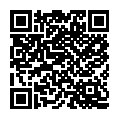
Order your personalized EITC/IS/IST Information security theory Certificate issued in Brussels providing an internationally recognized attestation of your professional skills to support your career.
You can also enrol for this European IT Certification in:
The enrolment fee above is the only fee that you will be charged for the whole certification programme. There are no time limits to finish the programme, as well as there are no limits in examination retakes available at no further fees.
European Information Technologies Certification Programme
EITC/IS/IST Information security theory Certification is an EU based IT competencies attestment in focused professional digital skillset of circa 15 hours reference programme equivalence.
This European IT Certification can be ordered separately or as a part of the EITCA/IS Information Security Academy with a set of other topically aligned EITC programmes.
Curriculum of the EITC/IS/IST Information security theory Certification covers range of relevant state-of-the-art topics organized in sections, providing attestment of your profesional skills (refer to the details in the Certification Curriculum tab above).
EITC Certification implements goals set out in the policy od the European Commission's Digital Agenda for Europe in its promoting digital literacy, skills and inclusion pilar by development and dissemination of the professional European IT Certification standard as important for supporting further growth of the Inclusive Digital Society and Knowledge Based Economy.
To acquaint yourself with the details on implementing of the EITC/IS/IST Information security theory Certification and its recognition please visit the How It Works section.All EITC Certification orders are subject to one month full money back guarantee. For further details on procedures check How it Works.
European IT Certification curricula are defined and developed in cooperation with academic and industrial IT experts associated with EITCI Institute. Each EITC Certificate concerns a certain, well-defined area of IT, most usually attesting proficiency in relevant software, tool or specific skillset with a proper understanding and practical abilities. EITC Certification curriculum is defined to encompass ca. 15 hours of learning workload, referencing step-by-step organized opean-access high quality learning materials, dividing the time between the lectures and the practical exercises in programme's dependent proportions.
- Structuring modern digital skills from beginner to advanced levels within EITC programmes
- Defining in-detail curricula for participants to prepare in asynchronous distant learning
- Referencing all complete didactic materials in multimedia formats covering EITC curricula
- Structuring the learning process in a step-by-step manner (programmes > lessons > topics)
- Supporting preparation to examination by incorporating partial quizes / tests into curricula referenced learning steps and providing unlimited consultancy with domain experts
- Implementing online EITC examinations with unlimited retakes at no additional fees for the participants who already have the knowledge on a relevant curriculum or gained it through the referenced learning materials
- Attesting skills referenced by relevant curricula with issuing digital EITC Certificates, confirming attaining of the competencies with a recognized European IT Certification standard
- Joining several EITC programmes into EITCA Academies certifying high-level specialization in a given domain of IT with EITCA Certificates (i.a. EITCA/CG Computer Graphics, EITCA/WD Web Development, EITCA/IS Information Security, EITCA/AI Artificial Intelligence, each grouping several relevant EITC Certifications in a given domain of applicable digital competencies)
- Learn more details on the European IT Certification (EITC) and the European IT Certification Academy (EITCA) at How it Works.
- In the European IT Certification framework the fee you pay upfront is a complete payment and no other fees are charged (the fee covers certification service and supportive services are provided at no additional charge)
- EITCI references adequately selected high quality online educational multimedia didactic materials including open-access, which are organized in a step-by-step manner to fully cover relevant Certification curricula
- EITCI as a non-profit EU organization aiming at international dissemination of high quality digital competencies charges for the certification, attesting that you have attained corresponding skills, covering the costs of the certification procedures (in English with reference AI assisted auto-translations) and related infrastructures
- EITCI in contrast to many other digital skills certification providers does not charge for the examination, you are only charged for a chosen certification and you have unlimited examination attempts allowing EITCI to verify if you are prepared (failing on an exam not meeting the minimal passing criteria, you will need to prepare properly and retake it at no additional fees and no limits on retakes)
- With EITCI supporting European Commission's Digital Skills and Jobs Coalition initiative the EITCA Certification fees are subsidized in order to support bridging the digital skills gap (EITCI DSJC subsidies are available globally and in case a participant discontinues the programme there are no requirements to return the subsidy)
- All of the EITCI certification fees are subject to the 30-days full money back guarantee extending the Consumer Rights Directive 2011/83/EU of the European Parliament and the Council
- European IT Certification formally attests your professional digital skills from Brussels, EU
- It will support digital career with internationally recognized IT competencies certification
- EITC/EITCA certified IT expertise is recognized by employers both in the EU and worldwide
- Over 1 million individuals globally have been issued European IT Certification since 2008
- European IT Certification curricula range from beginner to highly advanced programmes
- EITC Certification can be completed as quickly as in 2 days and EITCA Academy in 1 month
- You will have unlimited online access to consultations with relevant curricula experts
- All learning and examination-certification procedures will be implemented fully online
- You will have permanent access to updated EITC/EITCA programmes with didactic materials
- There are no extra fees for examination retakes, the enrolment fee is the only fee you pay
- You can use IT ID with EITC/EITCA certificates as a modern digital CV presenting your skills
- With any EITC/EITCA Certification you are admitted to membership in the EITCI Institute
- Your EITC/EITCA European IT Certification is secured in EITCI distributed blockchain
- Certifications are issued with integrated digital online validation mechanisms
By enroling for the European Information Technologies Certification EITC/IS/IST Information security theory you will have access to the complete didactic programme corresponding to the Certification Curriculum and the relevant examination procedure implemented fully remotely (with free additional retakes if required). Upon successful passing of the EITC/IS/IST examination a verifiable personalized EITC Certification will be issued in your name from Brussels under governance of the European Information Technologies Certification Institute EITCI, the accreditation and certification body for the programme. For all the details on the certification procedure please refer to How It Works section.
To review the indicative programme of the EITC/IS/IST Information security theory Certification, please click on the Certification Curriculum tab above.
You can enrol in the EITC/IS/IST Information security theory Certification by adding it to your order above. The EITC Certification accompanying didactic process will be an integrated auxilary service to help you define prerequsities and provide a complete curriculum for your EU based competencies and skills attestment.
The EITC/IS/IST Information security theory Certification specimen is following:
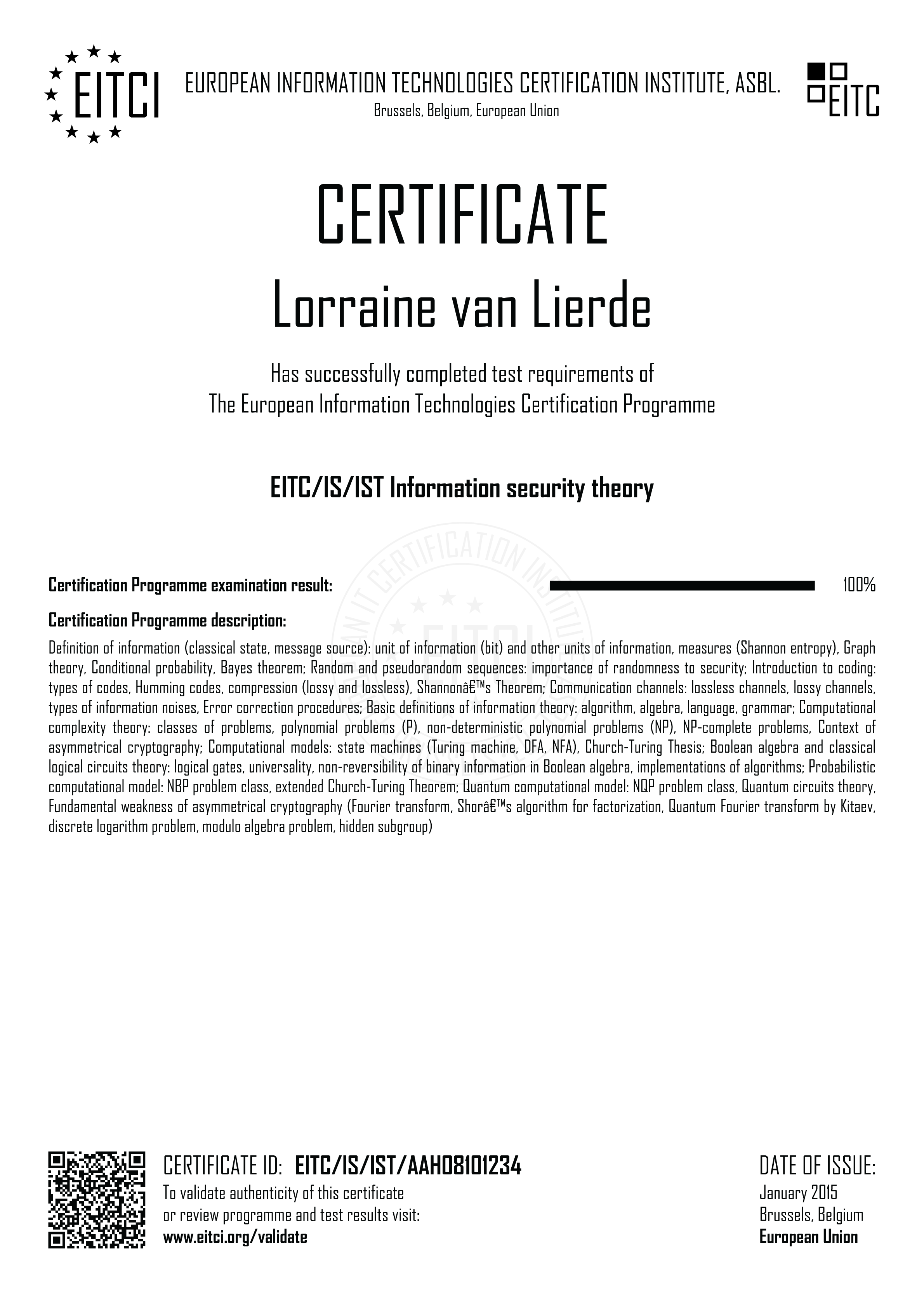
Certification Curriculum
Definition of information (classical state, message source): unit of information (bit) and other units of information, measures (Shannon entropy), Graph theory, Conditional probability, Bayes theorem; Random and pseudorandom sequences: importance of randomness to security; Introduction to coding: types of codes, Humming codes, compression (lossy and lossless), Shannon?s Theorem; Communication channels: lossless channels, lossy channels, types of information noises, Error correction procedures; Basic definitions of information theory: algorithm, algebra, language, grammar; Computational complexity theory: classes of problems, polynomial problems (P), non-deterministic polynomial problems (NP), NP-complete problems, Context of asymmetrical cryptography; Computational models: state machines (Turing machine, DFA, NFA), Church-Turing Thesis; Boolean algebra and classical logical circuits theory: logical gates, universality, non-reversibility of binary information in Boolean algebra, implementations of algorithms; Probabilistic computational model: NBP problem class, extended Church-Turing Theorem; Quantum computational model: NQP problem class, Quantum circuits theory, Fundamental weakness of asymmetrical cryptography (Fourier transform, Shor?s algorithm for factorization, Quantum Fourier transform by Kitaev, discrete logarithm problem, modulo algebra problem, hidden subgroup)
European Information Technologies Certificates Fully Online Validation
After you obtain your Certificate, you will never loose it. EITCI Institute will keep it safe and always accessible for you online.
Whenever you need it, you can validate your EITC/EITCA Certificate on-line at the EITCI Institute' website https://eitci.org/validate or on-the-fly by a seamless QR code scan with a mobile device.
Thus you can always summon a proof of having a formal attestation of your digital skills according to the Certificate curriculum along with your results in no-time. While validating your EITC/EITCA Certificates you can access Certification Supplements and download all documents (along with all the relevant Certifications issued to your name) in a PDF format or request additional authorized paper copies delivery by international postal service.
Watch the video below to check on how you can validate your Certificate instantly with a mobile phone with any standard, free QR scanner app. Both certification ID and your credentials are encrypted into a QR code printed on the Certificate. Take advantage of the EITC/EITCA Certification instant online validation using your mobile phone, e.g. during a job interview to impress your recruiter, presenting skills with proven formal attestation from Brussels, EU.
Scan the examplary QR code above yourself to check how the European IT Certification validation works or just click on it if you don't have a phone handy. This example is for the EITC Certification validation but you can also check how the EITCA Certification validation works (EITCA Certificate can be validated independently from the validation of all of its constituent EITC Certications, which can be validated from the EITCA Certificate level).
To manually validate your Certificate you will need to go to https://eitci.org/validate and input the Certificate's ID and the Holder last name (refer to the examples given below).
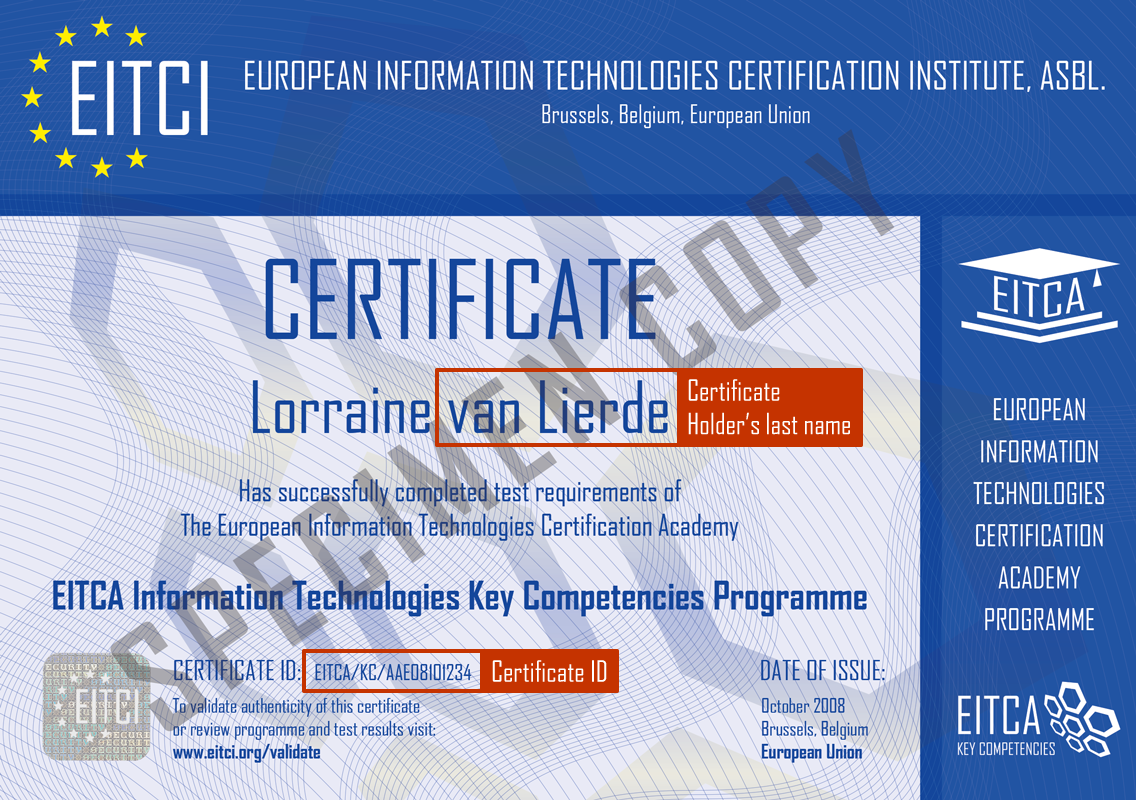
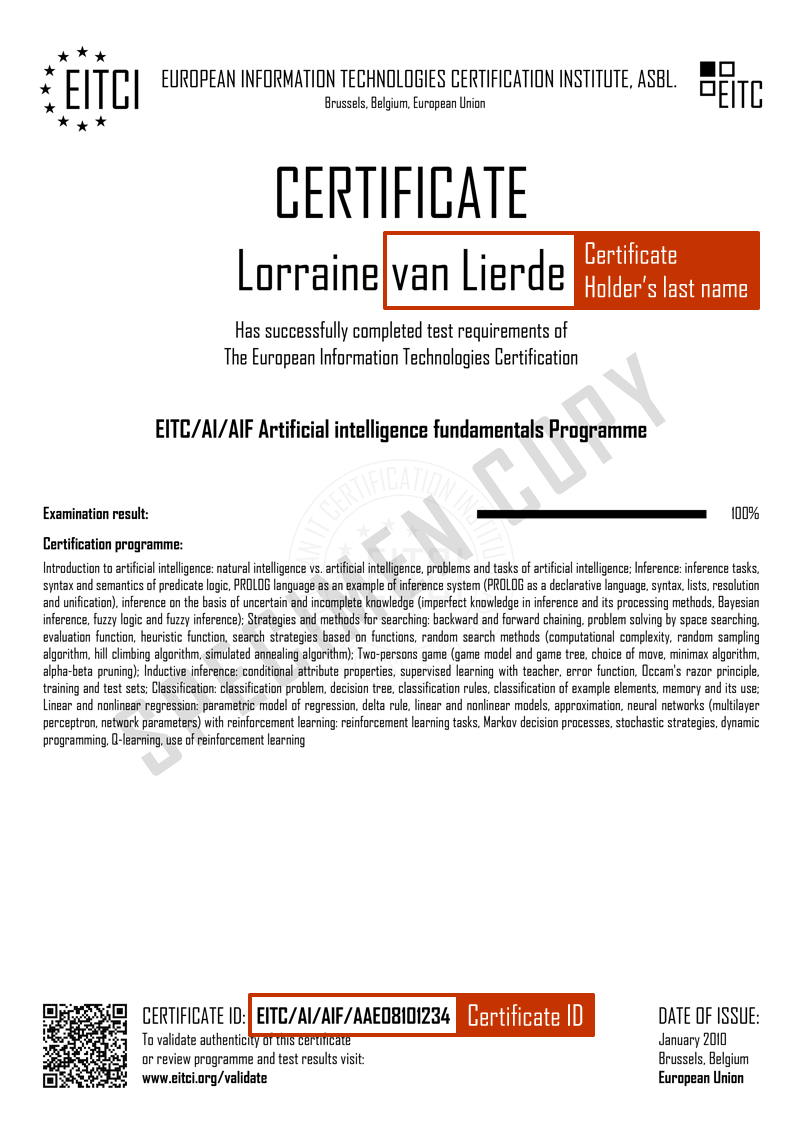
On the screenshot below you can see an exemplary validation of the EITC Certification.
Integrating EITC / EITCA Certificates with Your Professional Social Network
What do you do when you earn your IT Certification? Aside from putting it in your traditional CV, you'd want to showcase it on your professional social network. With EITC / EITCA you can levarage on the seamless integration with a leading global network for your career: LinkedIn.
Wait, just no account yet? Well, perhaps it's a high time to finally register one. EITCI Institute upon partnering with Microsoft's LinkedIn has integrated EITCA Academy along with EITC Certification standard with a platform's professional career profile presentation under official LinkedIn's acknowledgement and verification of added EITC/EITCA Certificates. Thanks to this integration EITCA and EITC Certificates holders are now able to add these personalized formal competencies attestements in an acknowledged way with the relevant European IT Certification logo, formal credentials and online proof of validity for an improved professional recognition.
EITCI Institute had implemented integration with the LinkedIn network in order to increase a general recognition of the EITC / EITCA IT Certification standard on the globally reaching, leading social network for professionals. In due process EITCA Academy was added in the LinkedIn's interface as an accredited academic institution dedicated to dissemination and attesting of IT competencies internationally in the EU and abroad, resulting with EITC/EITCA Certifications official endorsement and recognition by the LinkedIn professional networking platform. This means that all interested EITCA Academy alumnis and EITC/EITCA Certification holders may now add their Certifications including seamlessly integrated validation links (individually obtained at https://eitci.org/validate at the bottom of the validation webpage accessed after providing relevant Certificate data) containing individual Certificates' secured ID validation-access data. LinkedIn's system will automatically recognize those Certifications as linked with EITCA Academy official credentials and a relevant logo will be displayed on your professional profile documenting your formal IT education in Brussels, EU (thus increasing your job market competitiveness).
To learn more on integrating your EITC/EITCA Certifications with your professional LinkedIn social network profile watch the detailed video presentation below:
The European Information Technologies Certification Academy (EITCA) along with the European Information Technologies Certification (EITC) standard is an implementation of the European Commission's Digital Agenda for Europe upon the Europe 2020 Strategy in critical for Digital Society development of the EU IT Competencies Certification framework and its dissemination. The EITC/EITCA Certification is available for individuals worldwide fully on-line from Brussels under official governance of the European Information Technologies Certification Institute (EITCI), an accreditation and certification institution under the European IT Certification standard.
Beyond the EITC Programme, EITCA Academy since 2008 issues EITCA IT Certificates referenced to as equivalent with the level 6 of the EQF (the European Qualification Framework). Academic education within the EITCA Academy is also carried out under the ECTS (European Credit Transfer and Accumulation System) point systems for European higher education institutions, which enable recognition of relevant educational curricula. EITCA Academy actively participates in the new Erasmus+ European academic students exchange and EU funded IT internships programmes.
Additional information
| Vendor | |
|---|---|
| Level | |
| Discipline | |
| Academy | |
| Availability | No places left |
Other Certificates






